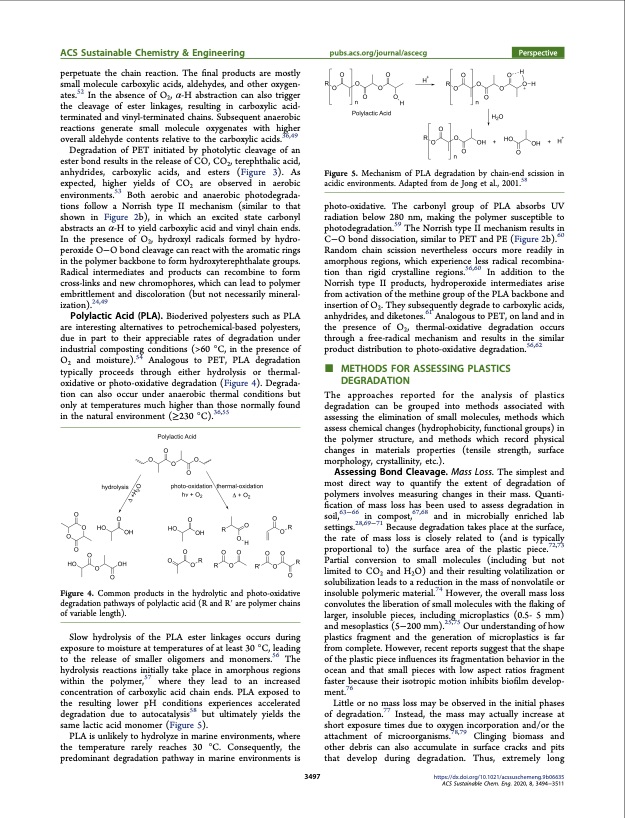
PDF Publication Title:
Text from PDF Page: 004
ACS Sustainable Chemistry & Engineering pubs.acs.org/journal/ascecg Perspective perpetuate the chain reaction. The final products are mostly small molecule carboxylic acids, aldehydes, and other oxygen- ates.52 In the absence of O2, α-H abstraction can also trigger the cleavage of ester linkages, resulting in carboxylic acid- terminated and vinyl-terminated chains. Subsequent anaerobic reactions generate small molecule oxygenates with higher overall aldehyde contents relative to the carboxylic acids.36,49 Degradation of PET initiated by photolytic cleavage of an ester bond results in the release of CO, CO2, terephthalic acid, anhydrides, carboxylic acids, and esters (Figure 3). As expected, higher yields of CO2 are observed in aerobic environments.53 Both aerobic and anaerobic photodegrada- tions follow a Norrish type II mechanism (similar to that shown in Figure 2b), in which an excited state carbonyl abstracts an α-H to yield carboxylic acid and vinyl chain ends. In the presence of O2, hydroxyl radicals formed by hydro- peroxide O−O bond cleavage can react with the aromatic rings in the polymer backbone to form hydroxyterephthalate groups. Radical intermediates and products can recombine to form cross-links and new chromophores, which can lead to polymer embrittlement and discoloration (but not necessarily mineral- ization).24,49 Polylactic Acid (PLA). Bioderived polyesters such as PLA are interesting alternatives to petrochemical-based polyesters, due in part to their appreciable rates of degradation under industrial composting conditions (>60 °C, in the presence of O2 and moisture).54 Analogous to PET, PLA degradation typically proceeds through either hydrolysis or thermal- oxidative or photo-oxidative degradation (Figure 4). Degrada- tion can also occur under anaerobic thermal conditions but only at temperatures much higher than those normally found in the natural environment (≥230 °C).36,55 Figure 5. Mechanism of PLA degradation by chain-end scission in acidic environments. Adapted from de Jong et al., 2001.58 photo-oxidative. The carbonyl group of PLA absorbs UV radiation below 280 nm, making the polymer susceptible to photodegradation.59 The Norrish type II mechanism results in C−O bond dissociation, similar to PET and PE (Figure 2b).60 Random chain scission nevertheless occurs more readily in amorphous regions, which experience less radical recombina- tion than rigid crystalline regions.56,60 In addition to the Norrish type II products, hydroperoxide intermediates arise from activation of the methine group of the PLA backbone and insertion of O2. They subsequently degrade to carboxylic acids, anhydrides, and diketones.61 Analogous to PET, on land and in the presence of O2, thermal-oxidative degradation occurs through a free-radical mechanism and results in the similar p■roduct distribution to photo-oxidative degradation.56,62 METHODS FOR ASSESSING PLASTICS DEGRADATION The approaches reported for the analysis of plastics degradation can be grouped into methods associated with assessing the elimination of small molecules, methods which assess chemical changes (hydrophobicity, functional groups) in the polymer structure, and methods which record physical changes in materials properties (tensile strength, surface morphology, crystallinity, etc.). Assessing Bond Cleavage. Mass Loss. The simplest and most direct way to quantify the extent of degradation of polymers involves measuring changes in their mass. Quanti- fication of mass loss has been used to assess degradation in soil,63−66 in compost,67,68 and in microbially enriched lab settings.28,69−71 Because degradation takes place at the surface, the rate of mass loss is closely related to (and is typically proportional to) the surface area of the plastic piece.72,73 Partial conversion to small molecules (including but not limited to CO2 and H2O) and their resulting volatilization or solubilization leads to a reduction in the mass of nonvolatile or insoluble polymeric material.74 However, the overall mass loss convolutes the liberation of small molecules with the flaking of larger, insoluble pieces, including microplastics (0.5- 5 mm) and mesoplastics (5−200 mm).25,75 Our understanding of how plastics fragment and the generation of microplastics is far from complete. However, recent reports suggest that the shape of the plastic piece influences its fragmentation behavior in the ocean and that small pieces with low aspect ratios fragment faster because their isotropic motion inhibits biofilm develop- ment.76 Little or no mass loss may be observed in the initial phases of degradation.77 Instead, the mass may actually increase at short exposure times due to oxygen incorporation and/or the attachment of microorganisms.78,79 Clinging biomass and other debris can also accumulate in surface cracks and pits that develop during degradation. Thus, extremely long https://dx.doi.org/10.1021/acssuschemeng.9b06635 Figure 4. Common products in the hydrolytic and photo-oxidative degradation pathways of polylactic acid (R and R′ are polymer chains of variable length). Slow hydrolysis of the PLA ester linkages occurs during exposure to moisture at temperatures of at least 30 °C, leading to the release of smaller oligomers and monomers.56 The hydrolysis reactions initially take place in amorphous regions within the polymer,57 where they lead to an increased concentration of carboxylic acid chain ends. PLA exposed to the resulting lower pH conditions experiences accelerated degradation due to autocatalysis58 but ultimately yields the same lactic acid monomer (Figure 5). PLA is unlikely to hydrolyze in marine environments, where the temperature rarely reaches 30 °C. Consequently, the predominant degradation pathway in marine environments is 3497 ACS Sustainable Chem. Eng. 2020, 8, 3494−3511PDF Image | Degradation Rates of Plastics in the Environment

PDF Search Title:
Degradation Rates of Plastics in the EnvironmentOriginal File Name Searched:
acssuschemeng-9b06635.pdfDIY PDF Search: Google It | Yahoo | Bing
Development of a solar powered Electric Ship The Electricship website originally started off as a project to develop a comprehensive renewable, affordable, modular electric ship... More Info
Modular Boat Hull Composite The case for a unsinkable, modular composite hybrid boat hull... More Info
MS Burgenstock Hybrid Electric Catamaran Lake Lucerne Unique shuttle servicing Lucerne to the Burgenstock Resort... More Info
Ground Power Unit GPU Powered by Lithium Ion Batteries The goal of the Ground Power Unit is to provide a readily accessible, modular, ready-to-power solution for remote power... More Info
| CONTACT TEL: 608-238-6001 Email: greg@electricship.com | RSS | AMP |